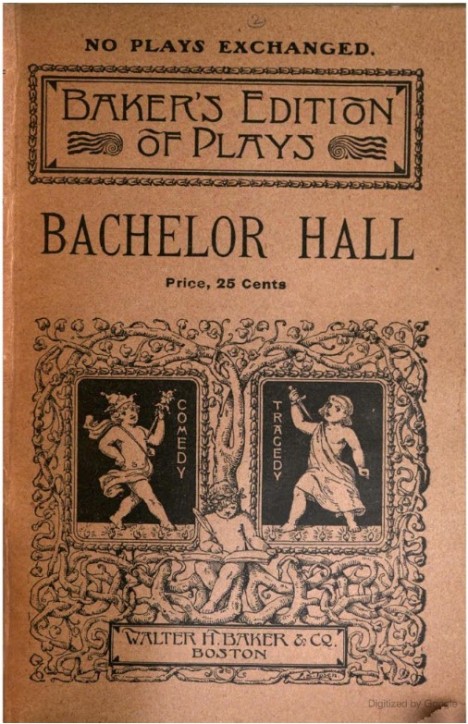On Friday, June 14, 1907, one-hundred and ten years ago today, the Norwalk High School Class of 1907 walked across the stage at the Gilmer Theater to receive their diplomas.
What did those young people experience that memorable evening? Well the Norwalk Daily Reflector and the Evening Herald reported extensively in their issues the next day, giving us a blow-by-blow description of the pomp and ceremony.
How did they look that night — these young people about to “join those who are fighting life’s battles,” as the Daily Reflector put it. How were they dressed? We don’t need to imagine. We have a photo taken that very evening at the Gilger. [1] Aren’t they are good looking crew?

Norwalk High School Class of 1907 Front Row: Ruth Jenkins, Irene Eline, Irene Bragdon, Myrtle Woodruff. Second Row: Lillian Smith, Eugene Bloxham, Arthur Young, Carrie Spurrier, Harriott Wickham, Robert Venus, Ruby Hoyt. Third Row: Sarah Barnett, Fred Osborne, Nina Humiston, Earl Sinclair, Florence Davidson, Inez Adams, Stephen Young, Fred French. Fourth Row: Homer Beattie, Florence Bascom, Alice McCammon, Sheldon Laning, Edna West, Harry Holiday, Cleo Collins.
The audience arrived at the Gilger to find the auditorium decorated with the school colors of black and gold and Stewart’s Orchestra playing “Slavery Days.” The Norwalk High School Classes of 1904 and 1906 occupied boxes decorated with their class colors. After all had settled into their seats, the curtain rose to reveal the Class of 1907, dressed as captured in the photo above, the women holding a single stemmed American rose. Above them hung a banner in black and gold, with the class slogan “Immer Siegend,” (always victorious). Accompanied by the orchestra, the class sang the chorus of the hymn, “A Dream of Paradise.”
Father in heaven above,
Glorious and mighty;
Send forth Thy Light of Love,
O King most mighty!
Father, Glorious and mighty;
Send forth Thy Light of Love.
Thy Light of Love. [2]
To great applause, the curtain lowered, and when it again raised, the class were seated in wicker chairs set in a semi-circle on the stage. With them were School Superintendent A. D. Beechy, the school faculty, and members of the board of education.
This graduation ceremony was not like what we experience today. There was no Valedictorian and Salutatorian, nor did a respected member of the community address the graduates. Instead, this ceremony focused on the graduates, with orations and essays by speakers selected for academic excellence, interspersed by musical performances by others in the class. [3]
Who were the speakers, and why were they chosen? The newspapers are handy references for this as well. Eight young men and women were honored in four categories: Arthur Young and Irene Bragdon for best grades in regular school work. Inez Adams and Alice McCammon for best grades in literary work; Sheldon Laning and Nina Humiston were chosen by the class; and Homer Beattie and Carrie Spurrier were chosen by the faculty. [4]
What did they talk about, these speakers? The subjects may surprise you. We’ll see what they said, and who they were, in subsequent posts, beginning with Mr. Young and Miss Bragdon.
Footnotes:
[1] The commencement photo is from the papers of Harriott Wickham, my grandmother,

who kindly wrote the names on the back. As I reported in my post, Mystery Girl, missing from this photo is Gertrude Ryerson. Newspaper accounts tell us that twenty-six graduates were at the ceremony, so I do not know why she is not in the commencement photo. It is a mystery. I clipped this image of her from a photo of the Senior / Junior study hall that I also found in my grandmother’s papers.
[2] “A Dream of Paradise,” by Claude Littleton, 1900. Full text of the lyrics and an audio file of the tune are at Hymnary. org.
[3] Lengthy descriptions of the ceremony and fulsome praise for the graduates are in “School Life is Ended,” The Norwalk Daily Reflector, June 15, 1907, page 1-2, column 6, and “Get Their Diplomas,” The Norwalk Evening Herald, pages 1,4.
[4] “Forty Seventh Annual,” The Norwalk Daily Reflector, June 13, 1907, page 1, column 3.“Get Their Diplomas,” The Norwalk Evening Herald, pages 1 and 4.
Thanks for visiting! Share and like this post below, and on Facebook. Let me know what you think in the comments. I’d love to hear from you!
Filed under: Alice McCammon, Arthur Young, Carrie Spurrier, Cleo Collins, Earl Sinclair, Edna West, Eugene Bloxham, Florence Bascom, Florence Davidson, Fred French, Fred Osborne, Gertrude Ryerson, Harriott Wickham, Harry Holiday, Homer Beattie, Inez Adams, Irene Bragdon, Irene Eline, Lillian Smith, Myrtle Woodruff, Nina Humiston, Norwalk HS Class of 1907, Norwalk OH High School, Robert Venus, Ruby Hoyt, Ruth Jenkins, Sarah Barnett, Sheldon Laning, Stephen Young, Uncategorized | Tagged: Adams Genealogy, Barnett Genealogy, Bascom Genealogy, Beattie Genealogy, Bloxham Genealogy, Bragdon Genealogy, Collins Genealogy, Davidson Genealogy, Eline Genealogy, French Genealogy, Holiday Genealogy, Hoyt Genealogy, Humiston Genealogy, Jenkins Genealogy, Laning Genealogy, McCammon Genealogy, Osborne Genealogy, Sinclair Genealogy, Smith Genealogy, Spurrier Genealogy, Venus Genealogy, West Genealogy, Wickham Genealogy, Woodruff Genealogy, Young Genealogy | Leave a comment »




























